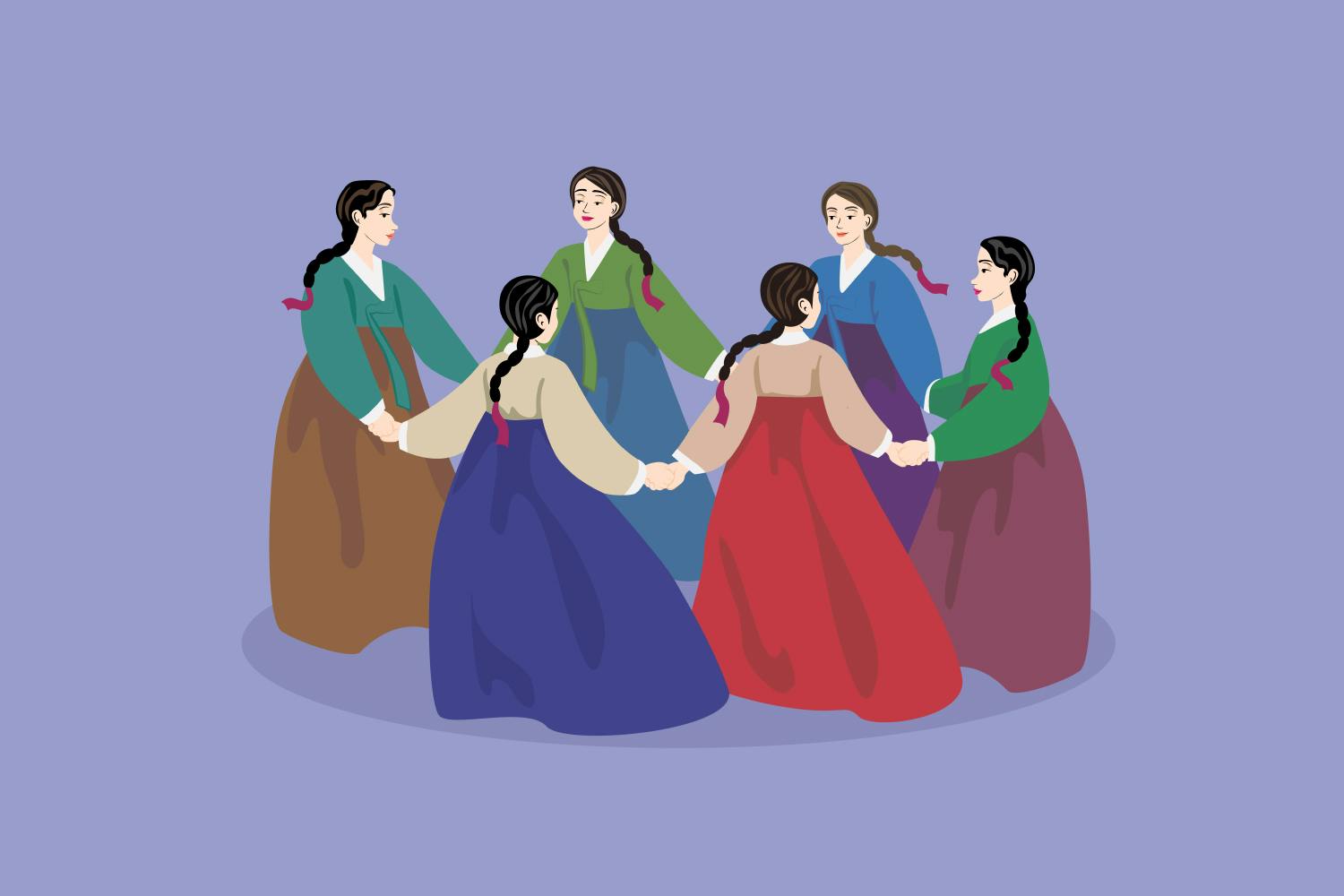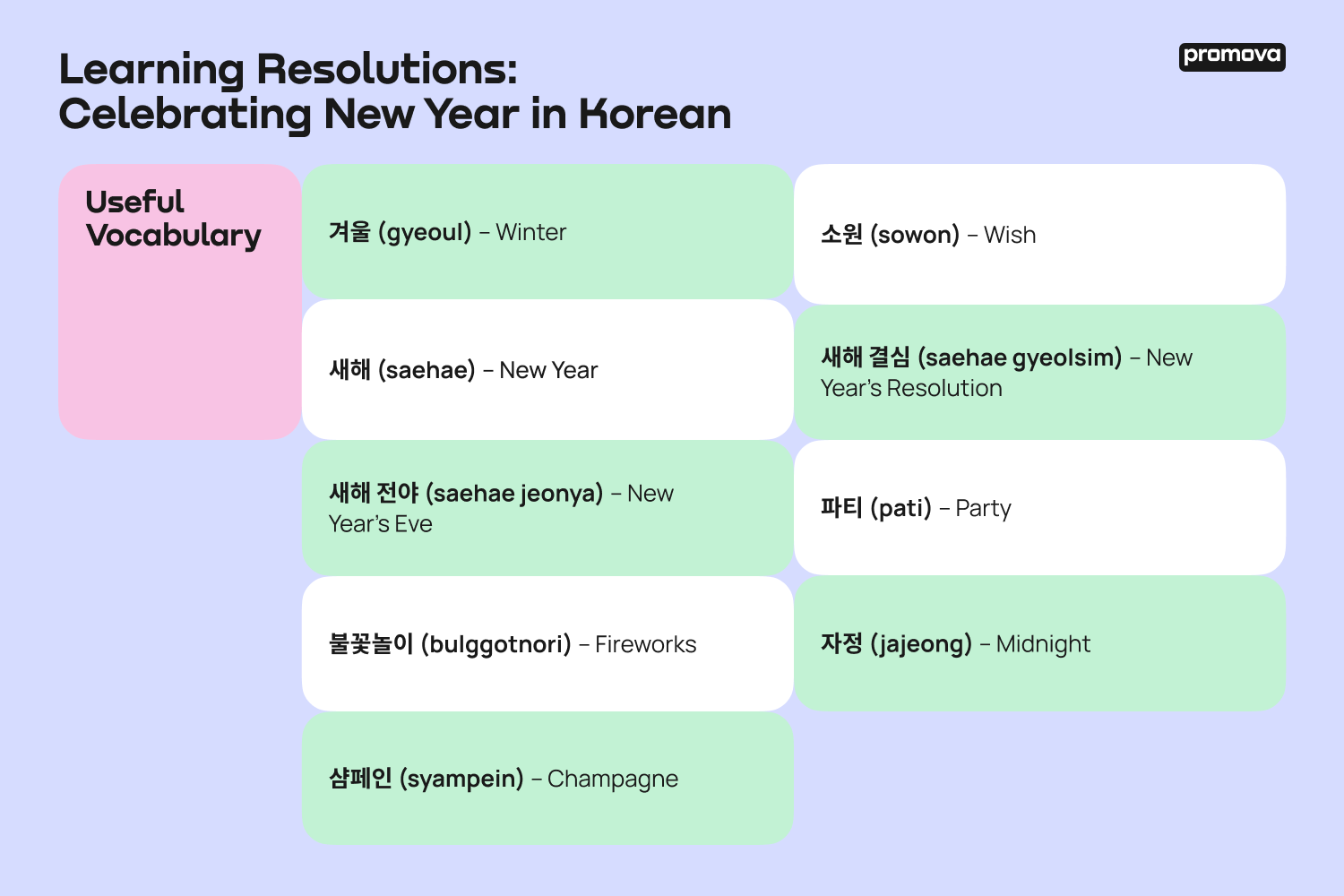Learning Resolutions: Celebrating New Year in Korean

Contents
We’ve already passed through Halloween, which means only one thing – we are officially at the beginning of the holiday season. This is truly the most wonderful time of the year. But today, we won’t talk about Christmas. Instead, we’ll visit East Asia and explore the Happy New Year Korean celebrations, traditions, and customs. Today’s article will become your ultimate guide through Korean greetings, common holiday expressions, and much more. So, without further ado, let’s dive right into it!
Korean Happy New Year: Why Are There Two of Them?
Do you know what’s great about Korea? It is that people there have not one but two New Years! The first holiday – 신정 [sindʑʌŋ] – Sinjeong, or Solar New Year, is the one akin to Western celebrations. The second one, 설날 [sʌllɑl] – Seollal, also known as Lunar New Year, is more of a traditional holiday. So what is the difference between these two days?
- Seollal is one of the most significant traditional holidays in Korea, usually falling between late January and mid-February in the Gregorian calendar. Families gather during this time to honor their ancestors, perform ancestral rites, and share meals together. Many people travel to their hometowns to be with their families during this period, resulting in one of the biggest migration events in Korea as people travel across the country.
- Sinjeong refers to the solar-based New Year celebration, which aligns more closely with the Gregorian calendar on January 1st. Sinjeong is more related to the Western concept of the New Year. It involves countdown events, fireworks, parties, and various cultural performances in urban areas. Many Koreans celebrate Sinjeong as a time for new beginnings, resolutions, and festivities similar to those in other parts of the world.
The coexistence of these two holidays is a great example of simultaneously cherishing cultural heritage and welcoming global traditions and celebrations. It’s a beautiful blend of ancient customs and modern festivities that reflect the diverse cultural identity of Korea.
Happy New Years in Korean: Learn to Celebrate Both
Most Korean greetings differ depending on various circumstances, including the level of formality and respect for the interlocutor. Therefore, when you wish someone a Happy New Year, it is essential to choose the appropriate expression. Below, you can find four common examples of greetings suitable for different settings.
Formal Korean New Year Greetings
Let’s start with the most official expressions. They will come in handy when you greet much older people or, for example, a person you greatly respect, like your teacher or boss. There are two phrases you can use in that situation.
- 새해 복 많이 받으십시오 (Sae-hae bok man-i ba-deu-shi-sseum-ni-o) – [sɛɛ boɡ mɑni bɑdɯsips*io] – Happy New Year.
This formal phrase is a great way to wish a happy Lunar Year in Korean. Literally, it means, “May you receive a lot of New Year’s blessings.” It’s appropriate to use in formal settings or when showing respect to elders. For example:
새해에는 건강과 행복이 함께하길 바라며, 새해 복 많이 받으십시오. (We wish you good health and happiness in the new year, Happy New Year.)
새로운 시작과 기회가 찾아와 새해 복 많이 받으십시오. (Happy New Year, with new beginnings and opportunities.)
새해가 풍요롭고 행복하길 바라며, 새해 복 많이 받으십시오. (Wishing you a prosperous and happy new year!)
- 새해 복 많이 받으세요 (Sae-hae bok man-i ba-deu-se-yo) – [sɛɛ boɡ mɑni bɑdɯsɛjo] – Happy New Year.
This phrase is the most common example of how to say Happy New Year in Korean. It is a polite and friendly expression suitable for various settings, both formal and informal. For example:
새해에 행복하고 건강한 시간 보내시고. 새해 복 많이 받으세요. (We wish you a happy, healthy, and prosperous new year.)
새해에 좋은 일들만 가득하길 바라며, 새해 복 많이 받으세요. (Wishing you all the best in the new year. Happy New Year!)
새로운 시작으로 기쁨과 희망이 가득하길, 새해 복 많이 받으세요. (May your new beginnings be filled with joy and hope, and Happy New Year.)
Informal Korean Lunar New Year Greetings
Casual greetings are much less official than the ones from the list above. They are great for wishing Happy New Year to your friends, family members, colleagues, or just people you are close with. There are also two informal New Year greetings in Korean.
- 새해 복 많이 받아 (Sae-hae bok man-i ba-da) – [sɛɛ boɡ mɑni bɑdɑ] – Happy New Year.
This phrase is a more casual and informal way to wish someone well for the New Year. It’s suitable for friends, peers, or those you’re close to. This expression is not as common as the previous one, but you can still hear it in casual conversations. For example:
새해 복 많이 받아! 올해에는 건강과 행복이 함께하길 바라요. (Happy New Year! May this year bring you health and happiness.)
새해 복 많이 받아! 새로운 시작으로 많은 좋은 일들이 생기길 기대해요. (Happy New Year! We’re looking forward to all the good things that come with a fresh start.)
새해 복 많이 받아! 새로운 한 해에 모든 소망과 꿈이 이루어지길 바라요. (Happy New Year! May all your hopes and dreams come true in the new year.)
- 행복한 새해 되세요 (Haengbokhan sae-hae doe-se-yo) – [hɛŋbokɑn tɛhɛ twɛtɛjo] – Happy New Year.
The last expression in our list is a great way to wish someone a happy New Year in a warm and friendly manner, suitable for both informal and more official settings. For example:
행복한 새해 되세요! 이 새해에는 가족과 함께 소중한 시간을 보내길 바랄게요. (Happy New Year! We hope you’re spending quality time with your family this year.)
행복한 새해 되세요! 새로운 시작으로 새로운 추억을 만들어 보세요. (Happy New Year! May you make new memories with a fresh start.)
행복한 새해 되세요! 이 새해에는 사랑과 행복이 가득한 시간을 보내길 바라요. (Happy New Year! May it be filled with love and happiness.)
1
Happy Chinese New Year in Korean: Useful Vocabulary
The Korean vocabulary is full of exciting words related to the New Year. Therefore, we are more than happy to share the most wonderful ones with you. It is a perfect way to learn something new about both the Korean language and the holiday itself.
- 겨울 (gyeoul) – [kjʌ.ul] – Winter.
겨울에는 눈이 많이 내리는 것이 일반적입니다. (In winter, it’s common to see a lot of snow.)
겨울이 되면 온기 있는 차 한 잔이 참 좋아요. (A cup of warm tea is so nice when winter comes.)
- 새해 (saehae) – [sɛɛ] – New Year.
새해에는 가족과 함께 저녁식사를 하곤 해요. (On New Year’s Day, I usually have dinner with my family.)
새해에는 새로운 시작을 하는 것이 좋아요. (It’s good to make a fresh start in the New Year.)
- 새해 전야 (saehae jeonya) – [sɛɛ dʑʌnja] – New Year’s Eve.
새해 전야에는 친구들과 함께 파티를 즐기는 거 좋아해요. (I enjoy partying with friends on New Year’s Eve.)
새해 전야에 불꽃놀이를 보는 거, 정말 멋지겠죠? (Watching fireworks on New Year’s Eve must be really cool, right?)
- 불꽃놀이 (bulggotnori) – [pulk*onnoɾi] – Fireworks.
불꽃놀이를 보면 마음이 편안해져요. (Watching fireworks is so relaxing.)
불꽃놀이를 위한 장소를 미리 예약해야 해요. (I need to reserve a place for fireworks in advance.)
- 샴페인 (syampein) – [sjampʰɛin] – Champagne.
샴페인 한 잔으로 축하를 표현하는 것이 전통입니다. (Celebrating with a glass of champagne is a tradition.)
샴페인은 보통 특별한 순간을 기념하기 위해 마시곤 해요. (Champagne is usually drunk to celebrate special moments.)
- 소원 (sowon) – [sowʌn] – Wish.
새해 소원이 뭐예요? (What’s your New Year’s wish?)
소원을 이루기 위해 노력해야 해요. (You have to make an effort to make your wish come true.)
- 새해 결심 (saehae gyeolsim) – [sɛ̝hɛ kʲʌl.ɕʰim] – New Year’s Resolution.
올해 새해 결심은 무엇인가요? (What’s your New Year’s resolution this year?)
새해 결심을 이루기 위해서는 계획이 필요해요. (To achieve your New Year’s resolution, you need a plan.)
- 파티 (pati) – [pha.tʰi] – Party.
새해를 맞이하여 친구들과 파티를 열었어요. (We had a party with friends to celebrate the New Year.)
오늘 저녁에 친구들과 작은 파티를 열 거예요. (I’m going to have a small party with friends tonight.)
- 자정 (jajeong) – [ja.dʑʌŋ] – Midnight.
우리가 자정에 만날 거야. (We’ll meet at midnight.)
자정에는 모든 것이 조용해져요. (Everything becomes quiet at midnight.)

Explore Promova: Your One-Stop Solution for Learning Korean
If your New Year’s resolution is to learn a new language, we have exciting news! Right now, you are one step away from achieving your goals. All you need to do is to install the Promova app – a convenient language-learning platform. After receiving the application, you access numerous benefits. Let’s explore just a few of them.
Firstly, we know how hard it is to implement language learning into a busy schedule. That is why Promova offers a bite-sized studying process that allows you to learn new information in only a few minutes a day. You can memorize new vocabulary and practice listening and pronunciation anywhere and anytime you want. Keep in mind that practice makes perfect, and with some consistency and effort, you will definitely achieve everything you want.
Another great thing about Promova is that you won’t find any unnecessary, boring materials here. Our interactive lessons are created with learners in mind. Language professionals did their best to make your studying fun and engaging. Moreover, each course is tailored to your needs and fluency level, so you will only learn the things that will be useful.
Finally, Promova allows you to learn more than one language at once. Don’t limit yourself! Here, you can master Korean, Spanish, German, French, Italian, and other tongues. It is a great opportunity to try different options and choose the one you are truly passionate about. And that’s not even the only benefit of Promova! Install the application now and see it yourself.
Conclusion
Although people across the globe have different traditions for celebrating New Year, there is still one thing in common. For many of them, it is the time when you can start over, set new goals, take stock of the past year, and wish the most incredible things to come true.
Today, we’ve glanced at Korean New Year traditions and greetings. And we hope that with this article, you’ll not only learn how to say happy New Year in the Korean language but also become one step closer to fulfilling your dreams
FAQ
What are some of the most common Korean New Year traditions?
Depending on the holiday, there are different customs. For Solar New Year, Koreans usually follow global traditions – exchange greetings, gift-giving, fireworks, etc. Lunar New Year typically includes 세배 (sebae), when younger family members perform a deep bow to elders, showing respect and receiving blessings. Also, it is common to wear 한복 (Hanbok) – Korean traditional clothing.
Are there different greetings for both New Years in Korean?
No, you can use the same greetings for both holidays. Since the purpose of all these expressions is to wish prosperity, happiness, and all the good things, they are suitable for Seollal and Sinjeong as well.
Is one New Year celebration more significant than the other one in Korea?
Traditionally, Seollal held greater significance in Korean culture due to its roots in Confucianism and the lunar calendar. However, the Western New Year has gained prominence in modern times due to globalization. Both hold cultural values, but differ in their focus and historical significance.
What are some common names of Korean traditional New Year’s food?
Traditional Korean New Year’s food includes many delicious meals. Some of the most common ones are 떡국 (Tteokguk) – rice cake soup, 전 (Jeon) – assorted savory pancakes, 약과 (Yakgwa) – honey cookies, and 잡채 (Japchae) – stir-fried glass noodles.
Comments